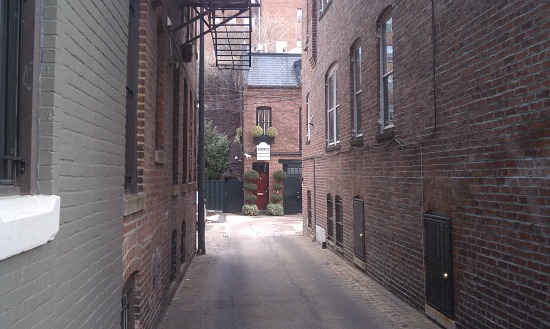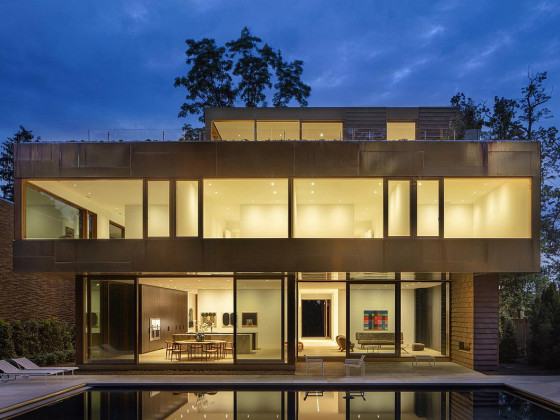 A Conversation About DC's Zoning Changes
A Conversation About DC's Zoning Changes
✉️ Want to forward this article? Click here.

Alley dwellings may become more popular with the changes.
In something of a kick-off to the public conversations that will ensue in the coming months regarding the city’s proposed zoning changes, Harriet Tregoning, the Director of the Office of Planning, and David Alpert, the founder of Greater Greater Washington, led a discussion last night at the Center for American Progress entitled “Modernizing DC’s Zoning Code.”
The conversation covered the history of the previous zoning code, the reasoning behind the changes, and some speculation as to what DC may look like when the changes go into effect. The Office of Planning is bringing the proposed changes to the Zoning Commission and, as Tregoning and Alpert both mentioned several times, the plans are not yet set in stone and comments from the public are welcome.
Here are a few of the proposed changes:
- First of all, the new zoning code will be much easier to navigate. Alpert demonstrated the circuitous clicking currently necessary if you want to find out what is allowable in your zone.
- Parking minimums will be eliminated downtown and in mixed-use zones that are close to mass transit, allowing developers to build projects without parking if they so desire. Tregoning elaborated that the new code would allow developers to “share parking,” perhaps making use of an existing underutilized parking lot rather than building a new one. Overall, DC wants to encourage walking, biking and using mass transit.
- A Green Area Ratio must be met in commercial, industrial and multifamily developments, allowing the city to set certain standards for stormwater management and other green elements. Residential developments will have to meet pervious surface standards.
- Some rules will change regarding accessory dwellings, with “in-law” suites and carriage houses to be allowed by-right in certain residential zones. As we wrote about previously, encouraging alley dwelllings may be a handy way to increase density and create mixed-income communities. In neighborhoods with detached single-family homes, the accessory dwelling regulations will actually be more limiting than those that are currently in place.
- Corner stores — small retail in a residential area — is encouraged under the proposed regualtions.
Both Tregoning and Alpert stressed the urgency of pushing through the changes as quickly as possible. As DC is in a development boom, they want to make sure that the city doesn’t “miss the wave.”
As far as timeline, the Zoning Commission will be reviewing the changes regarding parking, accessory dwelling units, building height measurement and the Green Area Ratio this summer, and making a decision about the entire code by the end of the year. The Office of Planning will be holding public meetings throughout the summer and fall to take comments from the community. (The hearings with the Zoning Commission will be public as well.)
Tregoning also discussed some city initiatives that don’t deal directly with the zoning changes and dropped a few cool facts. For example, more green roofs went up in DC last year than in any other city in the U.S. In fact, many of the zoning initiatives mentioned have a green slant: the District has a goal of creating enough green space so that every resident will be within 10 minutes of a park, Tregoning said, and wants to increase the tree canopy from 35 percent to 40 percent of the city.
You can find a current draft of the proposed zoning changes here.
See other articles related to: david alpert, harriet tregoning, office of planning, zoning, zoning changes, zoning code
This article originally published at http://dc.urbanturf.production.logicbrush.com/articles/blog/a_conversation_about_dcs_zoning_changes/5680.
Most Popular... This Week • Last 30 Days • Ever

With frigid weather hitting the region, these tips are important for homeowners to ke... read »

A new report from DC’s Office of Revenue Analysis highlights how millennials and wo... read »

The number of neighborhoods in DC where the median home price hit or exceeded $1 mill... read »

The DC-area housing market hit a sluggish patch in November, according to the latest ... read »

Chevy Chase apartment building sells at foreclosure auction; living in a storage unit... read »
DC Real Estate Guides
Short guides to navigating the DC-area real estate market
We've collected all our helpful guides for buying, selling and renting in and around Washington, DC in one place. Start browsing below!
First-Timer Primers
Intro guides for first-time home buyers
Unique Spaces
Awesome and unusual real estate from across the DC Metro













